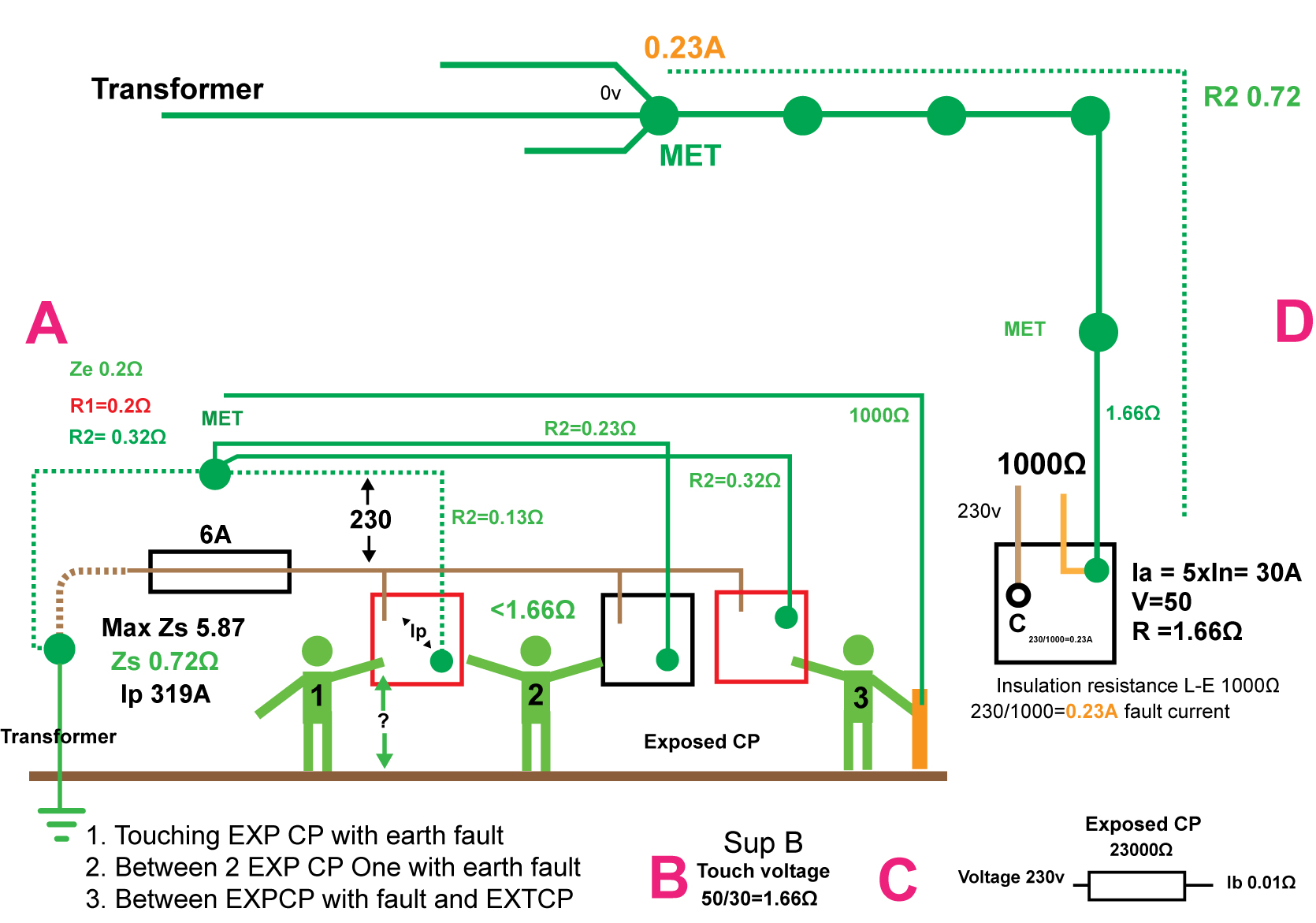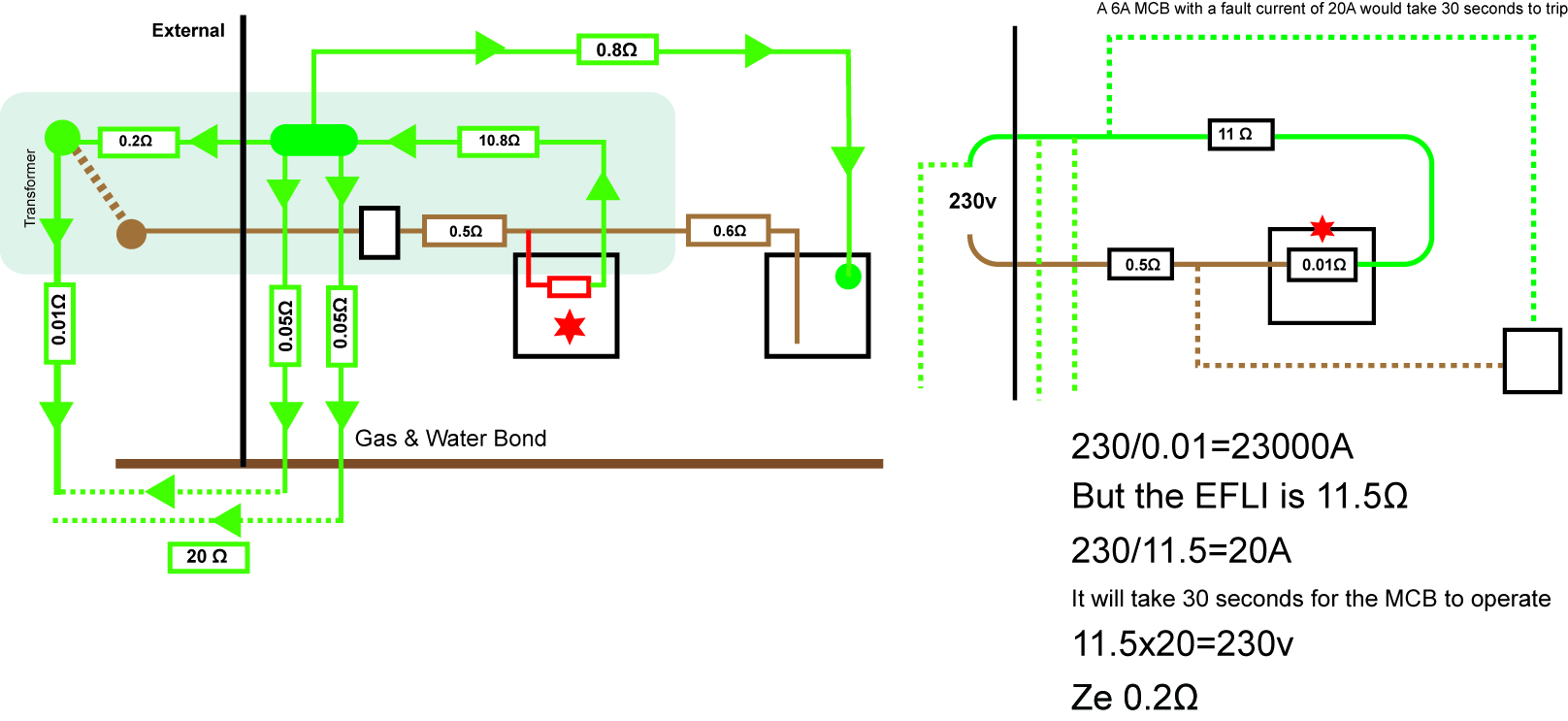I don't really understand touch voltage, I'm embarrassed to say...
When I ask people they usually say , stop over thinking it , the RCD will take care of it..
Im not to keen on leaving everything to an RCD, Ive found a few that don't work as expected..
I know the principle. And exposed conductive part can't reach a dangerous potential >50v
What I don't get is how the voltage can't rise above 50v.
230v is supplied to a class 1 switch.
There is a live earth fault. Chap No1 is touching it.
So the shock potential would be between his finger and his resistance to the floor.
The CPC will take the fault current around the EFLI path and trip the fuse within 0.1 - 5 seconds.
The Zs of 0.72Ω suggests the fault current will be 319A
Now if 319A appeared at the switch, even for 0.1 seconds, I would have though that would kill you.
That is a low impedance path though
Say his resistance to the floor is 1000Ω and the resistance back to the transformer is 1000Ω
so 2000Ω. 230/2000 = 0.11A.
But these resistances are never a constant, could be more or less, and 0.1A can still be dangerous. I also presume that when ADS was being designed, one of the calculations was not the possibility that you are wearing wellies.
Some other impedance must be involved.
So a 319A fault current is making its way around the loop, in the CPC, and for a brief moment, raising everything to a fault potential, until the OPD trips.
Chap 2 is touching the faulty switch and a switch with no fault.
He could be between 0v and 230v
But the CPC are commoned back at the met.
Now it this was in a special location we would want < 1.66Ω between them. If not, it needs supplementary bonding but 1.66Ω that quite a lot, but thats 50V
Chap 3 is touching another faulty switch, but also an extraneous CP with a resistance to the met of 1000Ω, but this is not bonded.
Chap 3 is in the trouble.?
So touch voltage must be limited. but how does it work.
You have 230 at the switch, but the metal work is limited to a rise above 50v
As in C- in the drawing (Should say Extraneous CP) a resistance of 23000Ω between you and 230v would give a fault current of 0.01A. That seems straight forward.
What resistance is in the way of the 230v to limit it to 50v
For a 6 amp circuit R <50/30=1.66Ω
So if two Exposed CP were measure to have 1.66Ω between them supplementary bonding is not needed. But that is with the voltage at 50v
So after all that waffle, simple question how is the 230 voltage restricted to 50v?
Oh and another bit....
That drawing on the right, if the fault current is only 0.23 amps, it won't trip the fuse, but 0.23 amps will be on all metal work, and you can feel that. No RCD
I hope that make some sense...
Thanks
When I ask people they usually say , stop over thinking it , the RCD will take care of it..
Im not to keen on leaving everything to an RCD, Ive found a few that don't work as expected..
I know the principle. And exposed conductive part can't reach a dangerous potential >50v
What I don't get is how the voltage can't rise above 50v.
230v is supplied to a class 1 switch.
There is a live earth fault. Chap No1 is touching it.
So the shock potential would be between his finger and his resistance to the floor.
The CPC will take the fault current around the EFLI path and trip the fuse within 0.1 - 5 seconds.
The Zs of 0.72Ω suggests the fault current will be 319A
Now if 319A appeared at the switch, even for 0.1 seconds, I would have though that would kill you.
That is a low impedance path though
Say his resistance to the floor is 1000Ω and the resistance back to the transformer is 1000Ω
so 2000Ω. 230/2000 = 0.11A.
But these resistances are never a constant, could be more or less, and 0.1A can still be dangerous. I also presume that when ADS was being designed, one of the calculations was not the possibility that you are wearing wellies.
Some other impedance must be involved.
So a 319A fault current is making its way around the loop, in the CPC, and for a brief moment, raising everything to a fault potential, until the OPD trips.
Chap 2 is touching the faulty switch and a switch with no fault.
He could be between 0v and 230v
But the CPC are commoned back at the met.
Now it this was in a special location we would want < 1.66Ω between them. If not, it needs supplementary bonding but 1.66Ω that quite a lot, but thats 50V
Chap 3 is touching another faulty switch, but also an extraneous CP with a resistance to the met of 1000Ω, but this is not bonded.
Chap 3 is in the trouble.?
So touch voltage must be limited. but how does it work.
You have 230 at the switch, but the metal work is limited to a rise above 50v
As in C- in the drawing (Should say Extraneous CP) a resistance of 23000Ω between you and 230v would give a fault current of 0.01A. That seems straight forward.
What resistance is in the way of the 230v to limit it to 50v
For a 6 amp circuit R <50/30=1.66Ω
So if two Exposed CP were measure to have 1.66Ω between them supplementary bonding is not needed. But that is with the voltage at 50v
So after all that waffle, simple question how is the 230 voltage restricted to 50v?
Oh and another bit....
That drawing on the right, if the fault current is only 0.23 amps, it won't trip the fuse, but 0.23 amps will be on all metal work, and you can feel that. No RCD
I hope that make some sense...
Thanks



